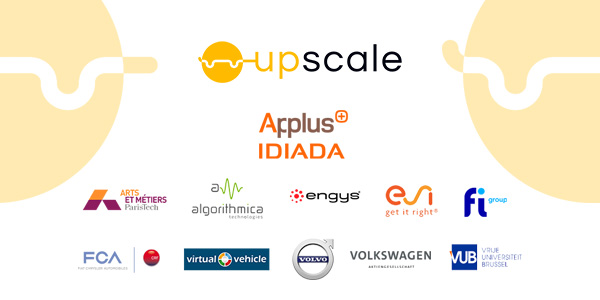What is the UPSCALE project about? In this interview, the team of Applus+ IDIADA, project coordinator, tell us about the objectives and key aspects of the project.
Applus+ IDIADA is an engineering company providing design, testing, engineering and homologation services to the automotive industry.
The main picture shows the other partners involved in this work package.
Why is this project innovative? What is the expected impact of the project on the automotive industry? We invite you to read it and find out by yourself!
A global revolution in electric vehicles is underway. According to the International Energy Agency by 2030 some 30% of all cars are expected to be electric. How the UPSCALE project will contribute to achieve or even exceed this figure?
Related to crash activity the project will introduce a new technique to characterise the battery cells and modules within battery packages. This new characterization will help to develop EV vehicles taking to account the risk of a short circuit.
The second key vehicle performance addressed in the UPSCALE project is vehicle aerodynamics. EV efficiency in highway driving is mainly linked with its aerodynamics and thus new EV designs need to be more and more streamlined. The UPSCALE project will develop innovative Computational Fluid Dynamic tools that provide near real-time aerodynamic simulations.
What are the main work phases the UPSCALE project is divided into?
We have identified 2 working areas, CFD and crash. Each area has 3 different project phases. The first is related to the implementation of the AI & ROM techniques, the second to the proof of concept and finally, the third phase is the demonstrator in full vehicle models.
CAE methods have been traditionally applied in the automotive industry from the concept definition until production release, how the application of Artificial Intelligence (AI) will revolutionize the electric vehicles design?
As it has been mentioned in a previous paragraph, the application of Artificial Intelligence will help in the crash area, by introducing a new way to characterise/estimate a short circuit. Ideally, to predict this event the CAE models should be run at the micro-scale environment, but this would entail a disproportionate cost in comparison to the standard crash simulations which are run at the macro-scale environment. In terms of aerodynamics designers will be able to modify the body design and know in near real-time the impact of these design changes in the aerodynamic coefficient.
How UPSCALE will work on the development and validation of CAE models to predict the mechanical behaviour a crash and aero-thermal simulations with the integration of artificial intelligence?
In the area of crash, the UPSCALE project will help by introducing a short circuit prediction that will work in macro-scale environment, that means keeping the actual crash simulation standards.
In the area of CFD, the UPSCALE consortium will develop different research strategies. On the one hand, we will develop a near real-time aerodynamic calculator and on the other hand, we will use AI to overcome some of the limitations of traditional CFD solvers, such as the accuracy of RANS turbulence models or the solver speed to solve the Poisson equation.
Improving the efficiency, reliability and the cost of the sub-systems and devices are also critical to mass-market electric vehicles. What impact the combination of CAE methods and AI will have on these?
AI solvers tend to be orders of magnitude quicker than simulating the real physics, based on that, its application to crash and aerodynamics analysis is really promising, however the trade-off between this acceleration and other related “costs”, such as, results accuracy, training cost or implementation and development costs, needs to be assessed.
The impact is related to the short circuit prediction. Currently, in vehicle development, the risk of short circuit is not predicted, the engineers simply over-engineer extra stiffness to the car structure in order to avoid any fracture or rupture of the battery package and surroundings. This over-stiffness will generate a higher deceleration in the occupant.
The electric vehicle revolution is currently stymied as well by the limitations of available batteries. How will the UPSCALE project try to improve the batteries?
UPSCALE will not improve the batteries. The UPSCALE project will improve the way we simulate the batteries in the field of crashworthiness, in order to be able to predict the risk of short circuit.
The computational complexity grows exponentially when accounting for turbulence, how turbulence modelling can be improved by using physics-informed machine learning methods?
The aim of our research on turbulence modelling is improving the accuracy and simulation cost of “simplified” turbulence models like RANS k-e or k-w, by means of training these solutions with more accurate results obtained by high fidelity solvers, such as, direct simulation, LES or Vortex Methods.
Which are the main challenges that the UPSCALE consortium will be facing the following six months?
The next six months are key because the consortium will define and develop the AI framework to model battery crash and get an enhanced aerodynamics simulation tool. So, the strategy implemented now will deeply affect the success of the Project.

